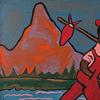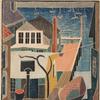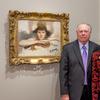Wine collecting has been hugely impacted by the internet age. It's no longer just for rich male snobs
- NEW YORK CITY, New York
- /
- March 25, 2016
One needn't look any further than the nearest laptop, PC or tablet to figure out the main driver behind fine and vintage wine's seeming meteoric rise as a hot category of collectible. The digital revolution – and, more to the point, the internet and information age – have catapulted wine collecting from a pastime once reserved for rich male snobs to persons of every conceivable stripe. And it's worldwide.
Starting in the early-to-mid 1990s, websites sprang up dedicated to fine wines, rare wines and the auction houses that sold them. Then, bidding platforms came into vogue – now-established entities such as LiveAuctioneers.com, Invaluable.com (formerly Artfact.com), iCollector and others made finding collectible wines at auction easier and more accessible. Researching wines also got simpler.
Then there was Barnebys.com – the Swedish-based auction aggregator that was started in 2011, quickly spread throughout Europe and Scandinavia and recently launched in the United States. Barnebys isn't a bidding platform; buyers go there to find what they're looking for and are directed to the auction houses listing with Barnebys that are featuring those items. One of their fastest rising categories is fine wines.
All these things have produced a seismic shift in the field, making wine collecting as we knew it from 20 years ago unrecognizable today. “For the most part, the old stereotype of the wine snob is a thing of the past,” said Jeff Zacharia, president of Zachys Wine Auctions in New York. “What we've seen is a democratization of the wine collecting world – more young collectors, more international collectors.”
“Back then, it was an older, male-dominated category, mostly affluent people in larger Western cities,” added John Kapon, CEO of Acker Merrall & Condit in New York. “Now, due to many influences and advancements worldwide, wine collecting has spread to almost every continent. Collectors today, on average, are much younger than 20-30 years ago. Asia and South America especially have emerged.”
Michael J. Moser, a specialist in the Fine Wines Department at Skinner's in Boston, said the base of bidders has become broader - “younger, less skewed toward academia and more female.” Marc Smoler, Marketing Manager of Hart Davis Hart in Chicago, said there really is no wine collector stereotype today. “They come from a myriad of backgrounds, with one thing in common: their passion for wine.”
Computers have been the driving force behind the changes. “The digital age has surely contributed to the rise in wine collecting,” Zacharia said. “Information is more accessible to wine drinkers, so more and more people are being attracted to the fine wine world. Also, wine apps like Delectable, and social media like Instagram, have made the social media aspect of fine wine collecting very common as well.”
But not so fast, says Kapon. “Passion doesn't occur just via pixels and digital. It happens when people around the world taste and experience the greatest wines anywhere, and so they become excited about wine and want to learn more and own more.” Doug Davidson of Bonhams' Fine Wines Department in San Francisco said the digital age has been a contributor to growth, but so has today's “foodie culture.”
Davidson said, “As people become more knowledgeable about food and the relationship between food and wine, the next natural step would seems to be an appreciation for collecting and aging wine.” But Ian Dorin, Heritage Auctions' New York Director of Fine Wine, took a more utilitarian viewpoint. “Because of the massive upward trend in prices, wine is being seen more and more as a commodity.”
Michael Moser agreed. “The fine wine market today more closely mimics a commodities market than a collectibles market. Net results are clearly higher now as compared to, say, 20 or 30 or even 100 years ago, even when taking inflation into account. But the ebb and flow of results is more akin to financial markets, and the effect of internet bidding is embedded into the system of bidding in general, I feel.”
Kapon said a lot has to do with simple economics. “The internet may provide great information, but that's less important than the fundamental impact on prices from increasing global incomes and the finite amount of the world's greatest wines produced. More people with more money, plus the same annual supply more or less, all equals rising prices. The macro basis for that is supply and demand.”
But how much impact has the internet had on the skyrocketing prices of wine at auction? A lot, Dorin said. “It was a total game-changer. Prices went through the roof, and as a result collecting wine has become incredibly popular. It's so easy, with computers, to be an informed and even sophisticated, collector.” Moser added, “The internet facilitates the dissemination of information on a global scale.”
Kapon said the web has made collectors less dependent on traditional wine critics to determine what they want to buy and collect. “That, in turn, has made wine collecting more fun and more 'democratic' in terms of who has access to what information, plus it makes it easier and faster to buy the wines that people love and collect. These factors have led to an increased demand, and more knowledge, of wine.”
Hart Davis Hart has been ahead of the curve for some time regarding the internet age. The firm's retail business has always been online – no brick and mortar storefront at all – which allows customers to buy wine from HDH 24 hours a day. Recently, the firm developed a bidding platform that allows bidders to place absentee and live bids from their smart phones, tablets or computers. It's a trend that's spreading.
Hart Davis Hart hosts seven live auctions a year at Tru Restaurant in Chicago. “While the auction room is constantly bustling, we also have hundreds of people participating online,” Smoler said. “The internet is useful for so many things: buying and selling wine, getting scores, reviews, producer profiles and general wine education materials, as well as cellar management software and market information.”
Zachys holds online wine sales once a month. In the process it's attracting a whole new demographic of buyer. “Smaller lot quantities and unique mixed lots are the perfect way for new buyers to expand their palate and for well-seasoned collectors to add unique finds to their collections,” he said. “The appetite for perfectly-aged bottles is huge. Our online sales are a big hit – hundreds of lots, hundreds of buyers.”
What about online sell-through? “Five or six years ago the percentage of winning bidders who came to us online was single-digits low,” Kapon said. “Today, the percentage of winning bidders is in the high teens, sometimes higher. It has grown significantly given the continuous improvements in technology, and the fact that our clients can participate in our auctions literally from anyplace around the world.”
Moser said 70 percent of Skinner's wine lots were presented in online-only sales during 2015. Smoler said the sell-through rates at Hart Davis Hart can vary greatly from sale to sale. “Often times our room bidders also submit absentee bids in advance of a sale on the digital platform, while other bidders will join the fray in the auction room for a few hours and continue bidding on their phones after they leave.”
Is wine collecting a global pursuit? Absolutely. “Wine collecting has has a very long history in the UK and Europe,” Davidson observed, “where having a cellar and 'laying down' wine has been a normal part of the household. The U.S. has come along in recent years as a stronghold, as has China.” The tipping point for Hong Kong came in 2008, when the import tax on wine went too zero. “We foresaw this, and entered the Hong Kong market immediately afterward, and we've been #1 ever since,” Kapon added.
Smoler said Asia continues to be Hart Davis Hart's leading international market, one that drives a large part of its business. “Private collectors and trade buyers in China, Japan, South Korea and Taiwan are influential segments of our clientele. Also, our business has expanded dramatically in Latin America in the last three years and Brazilian collectors continue to express a strong desire for fine and rare wines.”
Moser said wine collecting does have international appeal, though it tends to gravitate toward the more affluent societies. “Of course,” he said, “wine appreciation knows no borders. There will be collectors in virtually every corner of the globe. Religious beliefs and local laws are the only real barriers to wine appreciation.” Zacharia said Zachys' buying base “expands considerably worldwide with each auction.”
Of course, with all this success, the problem of fakes and forgeries has permeated the wine collecting hobby, as it has with coins, autographs, baseball cards and many other popular collecting categories. “Books have been written about it, and one person is spending 10 years in jail for it,” Dorin said of the problem as it pertains to wine. “The positive from this is that there is a major focus on eradicating it.”
Davidson said there's always been forgery in the wine world. “Pliny the Elder complained about it in ancient Rome,” he chuckled. “I wouldn't say the problem is rampant, but Bonhams is very careful to authenticate the wines we offer at auction.” Kapon said for years Acker Merrall subjects all the older vintages to a third-party inspection prior to sale. “It was groundbreaking then, standard practice now.”
Identifying the hottest trends in wine collecting is always fun speculation. “Bordeaux has always been the core of Hart Davis Hart's business,” Smoler said. “It's nearly 50 percent of the wine we sell. But in recent years Burgundy has become increasingly popular.” Heritage's Dorin said that Burgundy “is still king,” with Bordeaux keeping a high ranking in the market, adding, “Champagne has really taken off.”
Zacharia said Bordeaux and Grand Cru Burgundy are at the top of Zachys' list, adding, “In 2015, we sold over $7.5 million of DRC, $3.3 million of Lafite, $3 million each of Petrus and Mouton, and $2 million of Latour.” Kapon said there were eleven so-called “Million Dollar Brands” in 2015 – wines with total US sales of $1 million or higher. “Eleven out of eleven came from Bordeaux and Burgundy.”
Moser said the advent of the internet has given rise to some slightly more esoteric hot regions – diamonds in the rough, so to speak. “These would include Vega Sicilia in Ribera del Duero, Chateau Musar in the Bekka Valley, Sin Qua Non in the central coast of California, Egon Muller's wonderful Scharzhofberger Riesling in the Mosel, and others that might otherwise have flown under the radar.”
Smoler said the “blue chips” of wine collecting are still Bordeaux and Burgundy, with Napa in third place. “More people are collecting California wines now that they're comfortable with the labeling and terms,” he said. “From there, the natural flow is toward Bordeaux and the “Super Tuscans” of Italy, with a side-trip to Piedmont, Rhone, Rioja and, ultimately, Burgundy, with its purity of expression.”
Davidson said Burgundy's popularity can be tied to its limited production levels – many under 300 cases per year. “And the vintages are very variable, resulting in high global demand for the best wines from the best vintages. And while the number of consumers continues to grow, there's no way to produce more Montrachet.” He added Bordeaux remains popular with collectors “and always will be.”
He explained, “With the Bordeaux wines often lasting in the cellar effortlessly for 30-plus years, it's a natural collectible. The wines from the First-Growth estates, plus a few notable wines from the Right Bank estates – notably Le Pin and Petrus – are those that are most highly sought after by collectors.”
As for California wines, Davidson said they are also very notably sought after these days. “With the modern 'cult' wines such as Screaming Eagle and Harlan Estate, there has been a growing appreciation for well-preserved examples of the classic wines from California. We've seen wines such as Inglenook from the 1940s, '50s and '60s selling for thousands of dollars per bottle. I think that really says a lot.”
It must be pointed out that not all the news coming out of the wine collecting hobby is rosy. The wine-auction market actually fell by 2 percent between 2014 and 2015. In Hong Kong, the market dropped by 4 percent (to $98.2 million), while in London it tumbled by a more dramatic 15 percent. But New York picked up the slack, as sales were robust, leading to a substantial 27 percent gain for the year.
Leading the charge in New York was Sotheby’s two-part sale of the Don Stott collection, which totaled a staggering $13.5 million. Duncan Sterling, Sotheby’s Senior International Wine Specialist, said, “Bidders in the room, online and on the phone, all chased the rarest Burgundy, Rhone and Italian wines, all collected by Mr. Stott, who had an eye for purchasing the best wines from the greatest producers.”
For 2015, Acker Merrall & Condit led the field in worldwide sales, posting $69.9 million. It was followed by Sotheby’s ($60.4 million) and Zachys ($55.5 million). The U.S. leader was Hart Davis Hart, with $41.5 million in domestic sales last year. To learn more about wine collecting at auction, visit www.barnebys.com.
# # # #
Contact:
Ken HallBarnebys
770-842-0212
afreview@go-star.com
1055 Friendship Church Rd.
Powder Springs, Georgia
ken.hall@barnebys.com
(770) 842-0212
http://www.barnebys.com
















